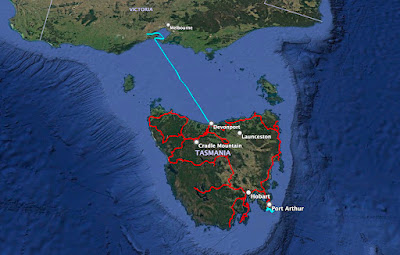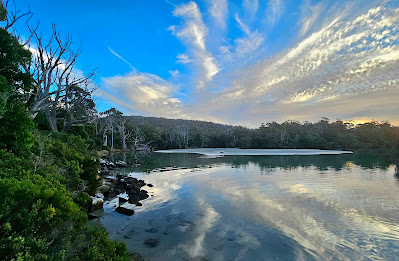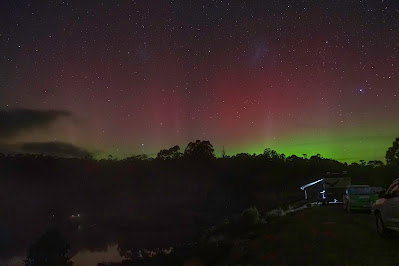We recently returned from 9 weeks travelling throughout Tasmania (Tassie) with the caravan in tow, having reached the island State aboard the Spirit of Tasmania.
We arrived into Tassie on the 29th January 25, once school holidays had finished, along with a ship full of other visitors, many also from Queensland.
| The queues of other travellers waiting to board the ship |
|
The original intention was not to write any form of blog, but a number of friends asked for something, so here we go but it will be shorter combined with photos.
So before you read any further, we need to be clear about what this blog is about and what it isn’t. You can therefore decide if you want to read on.
This post on Tassie is NOT about:
- A big focus on cities or towns, as we have been to Tassie a lot, so we were not focussed on these. A few are sort of covered, but not many.
- Tassie’s convict history or structures like bridges
- The more usual popular sightseeing destinations like The Wall, Mt Wellington, Mona, Constitution Dock etc.
If still reading on, our time in Tassie was focussed on visiting mainly Tassie’s many beautiful natural surrounds and ‘free camping’ as much as possible.
For the uninitiated, ‘free camping’ simply means finding somewhere to stay where we pay nothing or at worse, very little, say $10 a night. The good news in Tassie is, there are lots of free camping destinations, being part of how it attracts visitors.
Some caravan parks in towns were used to stock up on supplies and water, plus to wash clothes and sheets, typically every 2+ weeks.
Getting There
As already described, we got to Tassie by ship, an 11 hour journey, in our case during the day using pre-booked reclining seats and enjoying the food available on board. It was calm sailing both ways, which made Rob happy, as Bass Strait can get very rough.
 |
2 ships transit Bass Strait each day and this was the sister ship
passing us as we headed to Tasmania |
The Plan
The ship arrives in the north of the island at Devonport, and we had elected to travel clockwise around the coast of the island plus venturing inland as we went, to explore places not visited before.
Below is the actual usual travel route including the ships route, covering Tassie
 |
The blue line was the ships route and the red lines are
where we travelled during 9 weeks in Tasmania |
Additionally and to keep this succinct, the goal is to use less words and rely on photos to convey and share what we experienced with descriptive words under each.
Will also break down our travels into geographic indicative regions like north, south, inland etc with a rough route map for each.
Tassie is also famous for its fabulous selection of high quality and innovative food products to enjoy and trust us, we did enjoy, plus doing plenty of hiking helped to offset this indulgence!
North & North East
Straight off the boat at night, we found our way to good friends in Beaconsfield and set ourselves up in a paddock on their 10 acre farm-let near Beaconsfield, located on the banks of the beautiful Tamar River. We enjoyed 4 delightful nights with them and their hospitality.
 |
| Our van set up in a paddock next to our friends farm house |
There was also the opportunity to briefly visit Launceston to stock up on food due to quarantine restrictions when entering Tassie and to briefly visit nearby Evandale.
Our time with these friends, set us up well for the rest of the trip as we travelled across the north coast to our first conservation park which are free and plentiful across Tassie.
 |
Our route took us from Devonport across to top of
north west Tasmania to St Helens |
 |
Evandale is a quaint, neat small town which holds a
penny farthing race festival each year drawing thousands |
 |
Beaconsfield is famous for a mine collapse in 2006 when
17 people were trapped, 1died & 2 rescued 2 weeks later |
We spent 3 days in Waterhouse Conservation Park enjoying its remoteness and long beaches strewn with rocks. |
Where we camped but there were many locations along the coast
to choose from, all with clean pit toilets and great beaches |
 |
| Every day we would walk both directions along the beach |
 |
The shell is from abalone and a few people wearing wet
suits successfully went searching for them using snorkel/goggles |
East & South Coast
The east coast is very blessed with plenty to see and do with a beautiful coastline, small towns and many locations to free camp, which was very handy considering the number of others also visiting with caravans, motorhomes, camper trailers and tents of all sorts.
 |
We spent a ~4 weeks exploring along the east coast finishing,
crossing to an island and finishing at the southern most
location in Tassie reachable by car |
This coast is famous for its beautiful orange lichen covered boulders, very jagged coastline further south, historic pubs, islands to visit and very large trees. This part of Tassie is not one to rush, so we invested both time and stopping often to enjoy it.
Few things to look out for amongst the photos.
- We visited and stayed on Bruny Island, located close-ish to Hobart
- Whilst camping near Port Arthur, the in-famous convict prison, we took a boat tour down along the extremely rugged east coast, rounded Tasman Island and witnessed a feeding frenzy in the ocean involving a humpback, dolphins, seals, albatross & mutton birds.
 |
The weather changed at St Helens with strong winds whipping
up the seas making it more dramatic |
 |
We still got out walking across the rocks to enjoy the views
and the rough seas |
 |
The St Helens area is famous for the masses of orange
covered boulders along the coastline |
 |
Another free camping location, this time amongst trees
was at Lagoon Beach |
 |
| Yet another expansive beach to walk along each day at Lagoon Beach |
Further down the coast we ventured to Fortescue Bay which is the finishing point of the 3 Capes Walk and where we took a boat trip along the east coast out of Port Arthur.
 |
Camping in a Nat. Park amongst very
tall trees at Fortescue Bay |
 |
| Yet another very beautiful beach to enjoy at Fortescue Bay |
The boat trip along the coast and around Tasman Island was an absolute treat with 300 metre towering cliffs and a mass feeding frenzy happening around us
 |
Our boat trip hugged the coastline around Tasman Island whilst
also being surrounded by dolphins, seals, birds and following
humpback whale |
 |
| The boat we ventured out and along the coastline in |
 |
| Some of the coastline |
 |
One of the boats at the base of 300 mtr
cliffs... yes the boat looks insignificant |
 |
| The scene on the opposite side of Tasman Island |
 |
| Seals feeding upside down near the boat |
 |
| Dolphins surging past us |
 |
| Large numbers of Shy Albatross taking off |
After our boat trip we stayed near Hobart visiting Rob's relatives and trying our hand a taking night time photos |
First attempt at getting a photo of the Aurora Australis
on the bank of the Derwent River at Snug Harbour |
 |
The Milky Way shot through
the trees at Snug Harbour |
Near Hobart there is a destination called Bruny Island which we reached by crowded ferry and its renowned for good scenery and fine food produce. We stayed for 3 nights giving us ample opportunity to enjoy it. |
We enjoyed buying or trying some
fine food whilst on Bruny Island |
 |
| Stunning coastline can be found all around Bruny Island |
 |
| One of the first settler homes on Bruny Island |
 |
The island has 2 sections joined by 'The Neck'
which has a high viewing platform reached by
lots of stairs |
 |
We re-climbed the stairs at The Neck to again have
a go at capturing the Aurora Australis... |
 |
| ...and also the Milky Way |
 |
These 2 actual trees at Adventure Bay on Bruny were visited
by Capt. Cook in 1777 & a French explorer in 1779 |
The final destination down the south coast was Recherche Bay and the southern most road in Tasmania and the beauty of Tasmania just continued.
 |
At the end of the road to Recherche Bay and after a walk this sculpture
of a Southern Right whale stands in recognition of their sacrifices to whaling |
 |
| An inlet off Recherche Bay |
 |
| During sunset at Recherche Bay |
Inland to the West Coast
We had always wanted to return to the west coast, so worked our way there by exploring more of the inland of Tassie, and despite it still being technically summer/early spring, it got cold, for us… very cold.
Tasmania is also not a destination to enjoy long straight level roads, its more of a ‘roller coast’ road destination and through this section of the trip we ‘enjoyed’ constant and at times exhilarating driving.
 |
Our route to Strahan in the west involved backtracking via
Hobart to the famous Lake Pedder up to the Central Highland
and its lakes and then onto Strahan
|
 |
The mountainous road to the west provided multiple opportunities
to hike to waterfalls nestled in the lush rainforests |
 |
Within the forests of the Central Highlands
are very tall trees in old growth forests |
Inland Tasmania is blessed with numerous large lakes as part of its hydro electric infrastructure, one of the most famous being Lake Pedder where protests were held during the 1970s to stop the damming of various rivers like the Franklin.
 |
| One of the dams in the Lake Pedder area used to produce hydro-electricity |
 |
| We free camped down at the edge of the water of Lake Pedder |
 |
Our camp spot was peaceful briefly then we were joined by
many others enjoying a weekend with canoes & jet skis |
 |
The mornings at the lake were very peaceful with
silent jet skis drifting in the mist... |
 |
...and at night the lights of the campers
contrasted nicely with the Milky Way |
 |
At Arthurs Lake in the centre the day after we
arrived everyone else left so we were on our own |
 |
When the local campers next to us left the gave us 2 fresh trout
they had caught the day before along with timber and fire
lighters... such lovely people! |
 |
It was very cold at Arthurs Lake and the timber and means
to light it were thoroughly enjoyed |
West Coast
You may have noticed a large part of the island in the lower west we did not visit because there are no roads into it, but people can do multi-day hikes there.
Our main focus was to reach Strahan, then work our way to a place called Corinna, located in the Tarkine, the greatest expanse of cool temperate rainforest in Australia and 2nd largest in the world. It is also home to a very special timber called Huon Pine.
 |
Our route up this section of the west coast was on remote
dirt roads through bushfire ravaged & smouldering landscapes |
We had been here briefly before and because it is so beautiful, wanted to return but this was almost halted, due to extremely damaging and extensive bushfires, started by a massive dry lightning storm, not long after we arrived into Tassie.
All the roads into and throughout this part of the Tasmania were closed for many weeks as planes and helicopters, plus firefighters fought the bushfires, which ultimately burnt out almost 100,000 hectares or 250,000 acres of the pristine Tarkine forest.
The roads did open however, only a few days before we reached Strahan and our drive up the east coast on dirt roads amongst the devastation… was profound.
 |
Many visitors to Corinna arrive by crossing the Pieman River
whereas we had to drive in due to our car/caravan length |
 |
Visitors can either camp like us or stay small timber buildings
of various sizes and eat at the hotel/general store |
 |
| The accomodation is scattered and historically styled |
 |
Optional cruises along the Pieman River admiring the Tarkine
are available as our canoes or you can simply hike |
 |
One of the available boardwalks into the Tarkine
plus there are natural tracks following the river |
 |
| The natural beauty of the Tarkine is everywhere |
After Corinna we drove along the west coast amongst what was left after the bushfires and it was a very stark journey we made without passing any other vehicle
 |
| This area should have been covered with dense temperate rainforest |
 |
The green buds of re-growth was starting
and in contrast to the burnt sections |
 |
| With the road just opened the fire was still smouldering |
North West-ish
This section of our time in Tassie continued the coastline experiences, balanced with visiting some beautiful locations inland. It was here we continued with more foodie enjoyment in the form of Tassie’s wine, seafood, distillery products, pub grub and the highly renowned Cape Grim steak.
 |
Delicious, tender Cape Grim t-bone
and yes, there were some veggies |
It was also here we managed to play with some night time photography due to it being the Milky Way season and very fortunately, a more active Aurora Australis period.
 |
Our route through the north west included coastline and
going back inland to an iconic location plus multiple out
of the way free camping spots |
It was also here when in a few small towns and their surrounds, we enjoyed more of the local people’s warmth and friendliness, a constant throughout our time in Tas.
 |
The north west corner coastline was very rugged when we
emerged out of the bushfires of the Tarkine |
 |
| We revisited Stanley and 'the nut' |
 |
| The Nut viewed more closely from the beach |
 |
Tasmania has an abundance of crayfish
so we couldn't leave without trying some |
 |
The camping at Cradle Mountain was full so we stayed at a paid
spot 15 kms next to a large dam on private property.
The dam was stocked with various breeds of trout so had to have a go! |
 |
| Managed to catch 4 |
We visited Cradle Mountain Nat Park twice to walk around Dove Lake and take other walks available... such as beautiful but very busy place.
 |
Dove Lake at Cradle Mountain Nat. Park
with the cradle mountains behind it |
 |
| View whilst walking the path around Dove Lake |
 |
| The boat shed at the end of the Dove Lake Walk |
 |
| One of the walks in the park |
 |
| Another walk which is part of the Overland Track |
We weren't done with some night time photography and managed both another Milky Way and Aurora Australis photo at 3 am and in 3C degree temperatures. Worth it though. |
| To get the tree lit up, shone a torch on it for 1 second |
 |
The aurora was both a surprise and a real treat and very
different to what is experience in the Arctic |
Nine weeks was quite an extended stay and we now believe we have thoroughly experienced what Tasmania has to offer during both this visit, combined with the numerous others.
 |
Our final sampling of Tassie produce
was a set of gins to sample |
 |
Te Spirit of Tasmania arriving into Devonport the night before
our departure on it the following morning |
We hope those of you who have worked your way through this post have gained some insight to other locations which may also tempt you because Tasmania is certainly worth a visit to enjoy its many tourist destinations and events, the natural beauty of the island and the wonderful produce they create.
CLICK HERE for more photos of Tasmania 2025
CLICK HERE for a brief video - Tasmania 2025
We have plans for extended travels to new destinations later in 2025/26, so if interested, keep an eye out for these.



































































































